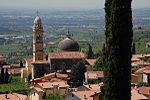Valpolicella (UK: , US: , Italian: [ˌvalpoliˈtʃɛlla]) is a viticultural zone of the province of Verona, Italy, east of Lake Garda. The hilly agricultural and marble-quarrying region of small holdings north of the Adige is famous for wine production. Valpolicella ranks just after Chianti in total Italian denominazione di origine controllata (DOC) wine production.The red wine known as Valpolicella is typically made from three grape varieties: Corvina Veronese, Rondinella, and Molinara. A variety of wine styles are produced in the area, including a recioto dessert wine and Amarone, a strong wine made from dried grapes. Most basic Valpolicellas are light, fragrant table wines produced in a novello style, similar to Beaujolais nouveau and released only a few weeks after harvest. Valpolicella Classico is made from grapes grown in the original Valpolicella production zone. Valpolicella Superiore is aged at least one year and has an alcohol content of at least 12 percent. Valpolicella Ripasso is a form of Valpolicella Superiore made with partially dried grape skins that have been left over from fermentation of Amarone or recioto.Winemaking in the region has existed since at least the time of the ancient Greeks. The name "Valpolicella" appeared in charters of the mid-12th century, combining two valleys previously thought of independently. Its etymology is likely from the Latin vallis pulicellae ("valley of river deposits"). Today Valpolicella's economy is heavily based on wine production. The region, colloquially called the "pearl of Verona", has also been a preferred location for rural vacation villas. Seven comuni compose Valpolicella: Pescantina, San Pietro in Cariano, Negrar, Marano di Valpolicella, Fumane, Sant’Ambrogio di Valpolicella and Sant’Anna d’Alfaedo. The Valpolicella production zone was enlarged to include regions of the surrounding plains when Valpolicella achieved DOC status in 1968. In December 2009, the production of Amarone and recioto dessert wines within the Valpolicella DOC received their own separate denominazione di origine controllata e garantita (DOCG) status.












